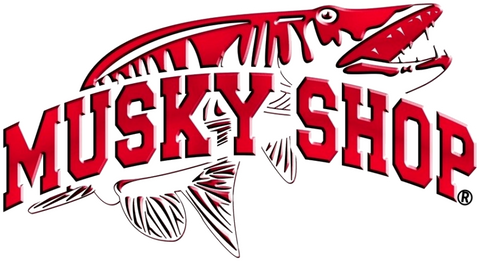Fascinating Facts about the Muskellunge

Here are some fascinating facts about the muskellunge:
Size and Appearance
Muskellunge closely resemble other esocidae, such as the northern pike and American pickerel. They typically measure 28–48 inches in length and weigh 15–36 lb. Some muskies have reached up to 6 ft in length and almost 70 lb. Their coloration varies from light silver to brown or green, with dark vertical stripes on the flank. The belly is white or cream-colored with brownish or grayish spots. The dorsal and anal fins can range from greenish to brownish to blood red, typically with dark markings. Muskie have a formidable set of teeth. Their upper jaw extends beyond the eye, while the lower jaw has a distinctive V-shaped notch. These sharp teeth help them ambush and capture prey. A reliable distinguishing feature is counting the sensory pores on the underside of the jaw: muskies have seven or more per side, while northern pike never have more than six.
Name Origins
The name "muskellunge" comes from the Ojibwe words maashkinoozhe, meaning "great fish," and mji-gnoozhe, meaning "bad pike" or "ugly pike. In English, there were at least 94 common names for this species before settling on "muskellunge." Some of those names were: Muskelunge, Muscallonge, Muskallonge, Milliganong, Maskinonge, Maskalonge, Mascalonge, and Maskalung. These various names reflect the rich history and regional diversity associated with this impressive freshwater predator.
Habitat and Behaviors
Muskellunge inhabit oligotrophic and mesotrophic lakes, large rivers, and the Great Lakes region. They prefer clear, cold water with temperatures between 67°F and 72°F. Shallow, weedy waters are favored during their early years, while larger individuals spend more time in deep water. In non-native areas, releasing muskies back into the water is discouraged due to their impact on native fish populations. Muskellunge are stealthy ambush predators, often hunting near submerged weeds and logs. They are sight feeders, primarily active during daylight hours.
Eyesight and Olfactory System
Muskellunge depend strongly on sight to find food. Their eyes are highly mobile, allowing them to track fast-swimming prey and see in practically any direction.
They also have incredible night vision but do not fare well in low-clarity waters. Like most freshwater fish, muskellunge have a pair of nostrils on either side of their face, known as “nares.” These nares are part of their olfactory system, allowing them to “smell” the underwater world around them. Fish pheromones convey important information. For example: Distress pheromones signal fear or stress (similar to sweating in humans). Natural pheromones indicate when it’s time to spawn. Muskies, like other fish, respond to these chemical cues in their environment. Digestive odors result from amino acids released during digestion. Heavy feeding windows in schooling fish can lead to increased digestive odors in the water. Food odors are recognized by muskies as preferred smells—whether plant-based forage or live prey.
Musky fishing, musky hunter, musky shop, musky lures, musky on the fly, musky fly fishing, musky flies, musky fever, musky addict, musky guide, musky shop guide service, muskie fishing, muskie nation, muskies, Canada, Northwoods, Wisconsin, muskies, fishing guides, fishing guide service, fiske, esox, pike, snoeken, rods, reels, lures, baits, line, leader, net, tackle box,
